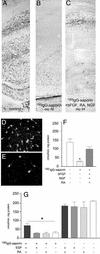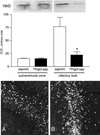Neural stem cells and cholinergic neurons: regulation by immunolesion and treatment with mitogens, retinoic acid, and nerve growth factor
- PMID: 12777625
- PMCID: PMC165874
- DOI: 10.1073/pnas.1132092100
Neural stem cells and cholinergic neurons: regulation by immunolesion and treatment with mitogens, retinoic acid, and nerve growth factor
Abstract
Degenerative diseases represent a severe problem because of the very limited repair capability of the nervous system. To test the potential of using stem cells in the adult central nervous system as "brain-marrow" for repair purposes, several issues need to be clarified. We are exploring the possibility of influencing, in vivo, proliferation, migration, and phenotype lineage of stem cells in the brain of adult animals with selective neural lesions by exogenous administration (alone or in combination) of hormones, cytokines, and neurotrophins. Lesion of the cholinergic system in the basal forebrain was induced in rats by the immunotoxin 192IgG-saporin. Alzet osmotic minipumps for chronic release (over a period of 14 days) of mitogens [epidermal growth factor (EGF) or basic fibroblast growth factor (bFGF)] were implanted in animals with behavioral and biochemical cholinergic defect and connected to an intracerebroventricular catheter. After 14 days of delivery, these pumps were replaced by others delivering nerve growth factor (NGF) for an additional 14 days. At the same time, retinoic acid was added to the rats' food pellets for one month. Whereas the lesion decreased proliferative activity, EGF and bFGF both increased the number of proliferating cells in the subventricular zone in lesioned and nonlesioned animals. These results are indicated by the widespread distribution of BrdUrd-positive nuclei in the forebrain, including in the cholinergic area. Performance in the water maze test was improved in these animals and choline acetyltransferase activity in the hippocampus was increased. These results suggest that pharmacological control of endogenous neural stem cells can provide an additional opportunity for brain repair. These studies also offer useful information for improving integration of transplanted cells into the mature brain.
Figures





References
-
- Zhang, R. L., Zhang, Z. G., Zhang, L. & Chopp, M. (2001) Neuroscience 105, 33-41. - PubMed
-
- Arvidsson, A., Collin, T., Kirik, D., Kokaia, Z. & Lindvall, O. (2002) Nat. Med. 8, 963-970. - PubMed
-
- Yagita, Y., Kitagawa, K., Ohtsuki, T., Takasawa, K.-I., Miyata, T., Okano, H., Hori, M. & Matsumoto, M. (2001) Stroke 32, 1890-1896. - PubMed
-
- Nakatomi, H., Kuriu, T., Okabe, S., Yamamoto, S., Kawahara, N., Tamura, A., Kirino, T. & Nakafuku, M. (2002) Cell 110, 429-441. - PubMed
Publication types
MeSH terms
Substances
Grants and funding
LinkOut - more resources
Full Text Sources
Other Literature Sources
Medical

